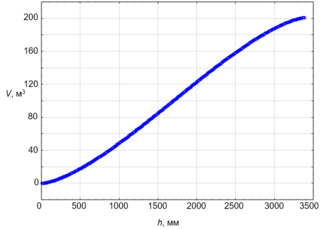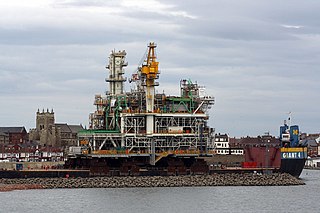Related Research Articles
Flow measurement is the quantification of bulk fluid movement. Flow can be measured in a variety of ways. The common types of flowmeters with industrial applications are listed below:
Well logging, also known as borehole logging is the practice of making a detailed record of the geologic formations penetrated by a borehole. The log may be based either on visual inspection of samples brought to the surface or on physical measurements made by instruments lowered into the hole. Some types of geophysical well logs can be done during any phase of a well's history: drilling, completing, producing, or abandoning. Well logging is performed in boreholes drilled for the oil and gas, groundwater, mineral and geothermal exploration, as well as part of environmental and geotechnical studies.

In petroleum and natural gas extraction, a Christmas tree, or "tree", is an assembly of valves, casing spools, and fittings used to regulate the flow of pipes in an oil well, gas well, water injection well, water disposal well, gas injection well, condensate well, and other types of well.
A wet gas is any gas with a small amount of liquid present. The term "wet gas" has been used to describe a range of conditions varying from a humid gas which is gas saturated with liquid vapour to a multiphase flow with a 90% volume of gas. There has been some debate as to its actual definition, and there is currently no fully defined quantitative definition of a wet gas flow that is universally accepted.

In fluid mechanics, multiphase flow is the simultaneous flow of materials with two or more thermodynamic phases. Virtually all processing technologies from cavitating pumps and turbines to paper-making and the construction of plastics involve some form of multiphase flow. It is also prevalent in many natural phenomena.
The Clair oilfield is an offshore oil field in Scottish territorial waters 75 kilometres (47 mi) west of Shetland in water depths of up to 140 metres (460 ft). The field is the largest oilfield on the UK Continental Shelf with an estimated 8 billion barrels of oil-in-place, according to the BP Plc’s website. It extends over an area of some 220 square kilometres (85 sq mi), covering five licence blocks.
The Everest gasfield is located in the Central North Sea, 233 kilometres (145 mi) east of Aberdeen, Scotland. It lies in the United Kingdom Continental Shelf blocks 22/9, 22/10a and 22/14a. The gasfield was discovered by Amoco in 1982 with first gas produced in 1993.

The Schiehallion oilfield is a deepwater offshore oilfield approximately 175 kilometres (110 mi) west of the Shetland Islands in the North Atlantic Ocean. The Schiehallion and adjacent Loyal field were jointly developed by BP on behalf of the Schiehallion field partners; BP, Shell, Amerada Hess, Murphy Oil, Statoil and OMV, and the Loyal field partners; BP and Shell.
An oil production plant is a facility which processes production fluids from oil wells in order to separate out key components and prepare them for export. Typical oil well production fluids are a mixture of oil, gas and produced water. An oil production plant is distinct from an oil depot, which does not have processing facilities.
The term separator in oilfield terminology designates a pressure vessel used for separating well fluids produced from oil and gas wells into gaseous and liquid components. A separator for petroleum production is a large vessel designed to separate production fluids into their constituent components of oil, gas and water. A separating vessel may be referred to in the following ways: Oil and gas separator, Separator, Stage separator, Trap, Knockout vessel, Flash chamber, Expansion separator or expansion vessel, Scrubber, Filter. These separating vessels are normally used on a producing lease or platform near the wellhead, manifold, or tank battery to separate fluids produced from oil and gas wells into oil and gas or liquid and gas. An oil and gas separator generally includes the following essential components and features:
- A vessel that includes (a) primary separation device and/or section, (b) secondary “gravity” settling (separating) section, (c) mist extractor to remove small liquid particles from the gas, (d) gas outlet, (e) liquid settling (separating) section to remove gas or vapor from oil, (f) oil outlet, and (g) water outlet.
- Adequate volumetric liquid capacity to handle liquid surges (slugs) from the wells and/or flowlines.
- Adequate vessel diameter and height or length to allow most of the liquid to separate from the gas so that the mist extractor will not be flooded.
- A means of controlling an oil level in the separator, which usually includes a liquid-level controller and a diaphragm motor valve on the oil outlet.
- A back pressure valve on the gas outlet to maintain a steady pressure in the vessel.
- Pressure relief devices.

Custody Transfer in the oil and gas industry refers to the transactions involving transporting physical substance from one operator to another. This includes the transferring of raw and refined petroleum between tanks and railway tank cars; onto ships, and other transactions. Custody transfer in fluid measurement is defined as a metering point (location) where the fluid is being measured for sale from one party to another. During custody transfer, accuracy is of great importance to both the company delivering the material and the eventual recipient, when transferring a material.
Black powder is an industry name for the abrasive, reactive particulate contamination present in all gas and hydrocarbon fluid transmission lines. Black powder ranges from light brown to black, and the mineral makeup varies per production field around the world.

Tracerco is the oil and gas services subsidiary of British chemical company and conglomerate Johnson Matthey.
Roxar AS was a provider of products and associated services for reservoir management and production optimisation in the upstream oil and gas industry. Roxar was headquartered in Stavanger, Norway and operated in 19 countries with around 900 employees. Roxar offered software for reservoir interpretation, modelling and simulation, as well as instrumentation for well planning, monitoring, metering and production optimisation. Roxar was acquired by Emerson Electric Company in April 2009.

Spinlock is a technology based company specialized in the manufacture and development of nuclear magnetic resonance (NMR) and nuclear quadrupole resonance (NQR) equipment.
In the petroleum industry, a well test is the execution of a set of planned data acquisition activities. The acquired data is analyzed to broaden the knowledge and increase the understanding of the hydrocarbon properties therein and characteristics of the underground reservoir where the hydrocarbons are trapped.

The Buzzard Oil Field is an oil field located in the North Sea Blocks 19/10, 19/5a, 20/6 and 20/1s. It was discovered in 2001 by PanCanadian, and developed initially by PanCanadian's successor EnCana and then by Nexen. The oil field was initially operated and owned by Nexen which is now a subsidiary of China's CNOOC.
In the petroleum industry, allocation refers to practices of breaking down measures of quantities of extracted hydrocarbons across various contributing sources. Allocation aids the attribution of ownerships of hydrocarbons as each contributing element to a commingled flow or to a storage of petroleum may have a unique ownership. Contributing sources in this context are typically producing petroleum wells delivering flows of petroleum or flows of natural gas to a commingled flow or storage.

Industrial Tomography Systems plc, occasionally abbreviated to ITOMS or simply ITS, is a manufacturer of process visualization systems based upon the principles of tomography. Headquartered in Manchester, UK, the company provides instrumentation to a variety of organisations across a range of sectors; including oil refining, chemical manufacturing, nuclear engineering, dairy manufacturing, and research/academia.

GE Oil & Gas was the division of General Electric that owned its investments in the petroleum industry. In July 2017, this division was merged with Baker Hughes.
References
- ↑ Department of Trade and Industry (UK), ‘Guidance Notes for Petroleum Measurement’, Issue 7, December 2003, pp. 8–9.
- ↑ Scheers, A.M., Noordhuis, B.R., ‘Multi-phase and Wet Gas Flow Measurement’, 5th Annual Multi-Phase Metering Conference, Aberdeen, Scotland, 1999.
- ↑ "Christian Michelsen Institute". www.cmr.no. Retrieved 8 October 2017.
- ↑ "Norwegian Society for Oil and Gas Measurement". www.nfogm.no.
- ↑ Mehdizadeh, P., ‘Multiphase Measuring Advances Continue’, Oil & Gas Journal, 9 July 2001.
- ↑ Mehdizadeh, P., ‘2006 Worldwide Multiphase and Wet Gas Metering Installations’, Production Technology Report 03232007, 2007.
- ↑ "Saher Flow Solutions".
- ↑ Scheers, L., Busaidi, K., Parper, M., Halovorsen, M. and Wideroe, T., ‘Multiphase Flow Metering Per Well – Can it be Justified?’, 20th North Sea Flow Measurement Workshop, St. Andrews, Scotland, 2002.
- ↑ Babelli, I.M.M., ‘In Search of an Ideal Multiphase Flow Meter for the Oil Industry’, Arabian Journal of Science and Engineering, Volume 27, Number 2B, October 2002, pp. 113 – 126.